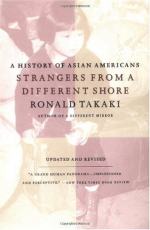
|
| Name: _________________________ | Period: ___________________ |
This test consists of 15 multiple choice questions and 5 short answer questions.
Multiple Choice Questions
1. On what island did the author grow up?
(a) Rikers.
(b) Maui.
(c) Long Island.
(d) Oahu.
2. How many Asians arrived in Hawaii between 1850 and 1920?
(a) 1,000,000.
(b) 50,000.
(c) 300,000.
(d) 100,000.
3. What caused the strike with the Central Pacific Railroad to end?
(a) The Central Pacific Railroad threatened to hire black men instead.
(b) An agreement was reached.
(c) The Chinese people found a better company to work for.
(d) Central Pacific Railroad went bankrupt.
4. When did the first wave of Asian immigration begin?
(a) Immigration Act of 1924.
(b) The Cold War.
(c) Immigration Act of 1968.
(d) With the Mayflower.
5. During 1970-1980 how many immigrants were Asian?
(a) One third.
(b) 1,099,002.
(c) 100%
(d) Half.
6. When was the foreign miners' license tax imposed?
(a) 1992.
(b) 1801.
(c) 1956.
(d) 1852.
7. When did William Hoper open his sugar mill?
(a) 1897.
(b) 1835.
(c) 1972.
(d) 1902.
8. What were the names of the secret societies formed to protect Asian members?
(a) Tongs.
(b) The Free Masons.
(c) The Mighty Steeds.
(d) Mongs.
9. Who signed a law prohibiting Japanese from migrating from Hawaii to the mainland?
(a) President Kennedy.
(b) President Roosevelt.
(c) President Ford.
(d) President Nixon.
10. What did immigrants think about Hawaii? Why did they go there?
(a) Easy access to fishing.
(b) It had a low cost of living.
(c) It was paradise.
(d) It was near the beach.
11. Why did Chinese immigrants begin to open laundromats?
(a) The initial capital was low.
(b) They were fired from the railroad.
(c) Familes could run the buisness.
(d) There was a great need for the service.
12. Why did very few Chinese immigrants return to China according to The Chinese Six Companies?
(a) No money.
(b) Lack of family.
(c) The government would not let them return.
(d) No passport.
13. What location became the prime meeting spot for Chinese immigrants?
(a) Laundromats.
(b) Stores.
(c) Restaraunts.
(d) Shopping malls.
14. Where did Takaki go to college?
(a) The East coast.
(b) The South.
(c) The Midwest.
(d) The West coast.
15. What does diversity in the work place accomplish according to Chapter 2?
(a) It prevents one block of immigrants from becoming too powerful.
(b) The bosses experience multiple cultures.
(c) It makes a positive work environment.
(d) It provides an educational experience.
Short Answer Questions
1. In what year was a law passed that prohibited Japanese from owning land?
2. Who did William Hoper find to be unproductive workers at his sugar mill?
3. Who believed that the Japanese should have the goal of being settlers?
4. What made Chinese immigrants a threat to the mining industry?
5. Why did Chinese workers strike while working on the railways?
|
This section contains 396 words (approx. 2 pages at 300 words per page) |

|




